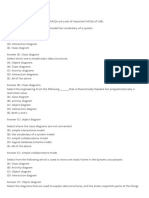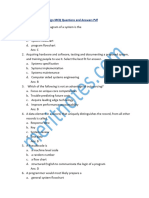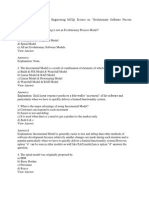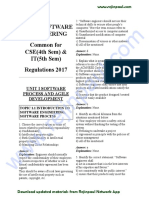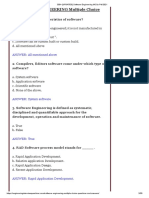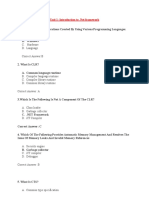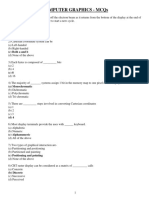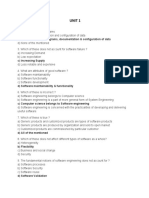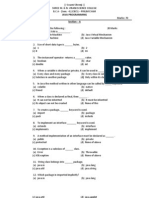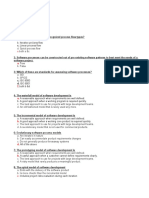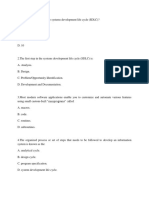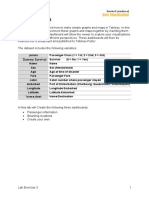SW-2: MCQ on Lecture 6 (part1)
1. Which type of UML diagram is used to depict the overall structure of a system?
a) Use Case Diagram
b) Class Diagram
c) Sequence Diagram
d) Activity Diagram
Answer: b) Class Diagram
2. Which UML diagram is used to model the interactions among objects, emphasizing the sequence
of events?
a) Use Case Diagram
b) Class Diagram
c) Sequence Diagram
d) State Diagram
Answer: c) Sequence Diagram
3. Which UML diagram is used to represent the dynamic behavior of a system, showing how objects
change state?
a) Class Diagram
b) Sequence Diagram
c) State Diagram
d) Communication Diagram
Answer: c) State Diagram
4. The "is-a" relationship between classes is represented by which UML construct?
a) Association
b) Inheritance
c) Aggregation
d) Composition
Answer: b) Inheritance
5. Which UML diagram is used to illustrate the interactions between objects, emphasizing the
relationships and messages exchanged?
a) State Diagram
b) Use Case Diagram
c) Communication Diagram
d) Activity Diagram
Answer: c) Communication Diagram
6. Which UML diagram represents the functional requirements of a system from the perspective of
its users or external actors?
a) State Diagram
b) Class Diagram
c) Use Case Diagram
d) Deployment Diagram
Answer: c) Use Case Diagram
7. Which UML diagram is used to model the workflow or flow of actions in a system?
a) Deployment Diagram
b) Use Case Diagram
c) Activity Diagram
d) Component Diagram
Answer: c) Activity Diagram
8. What does a solid line with an arrowhead represent in a UML class diagram?
a) Association
b) Aggregation
c) Inheritance
d) Dependency
Answer: a) Association
9. Which UML diagram is used to show the physical deployment of software components on
hardware nodes or devices?
a) Deployment Diagram
b) Object Diagram
c) Package Diagram
d) Component Diagram
Answer: a) Deployment Diagram
10. Which UML diagram is used to represent the organization of classes into packages or modules?
a) Deployment Diagram
b) Object Diagram
c) Package Diagram
d) Component Diagram
Answer: c) Package Diagram
11. Which UML diagram represents a snapshot of the system at a specific point in time, showing
objects and their relationships?
a) Object Diagram
b) Use Case Diagram
c) Deployment Diagram
d) Component Diagram
Answer: a) Object Diagram
12. Which UML diagram is used to depict the physical components or software modules of a system
and their dependencies?
a) Component Diagram
b) Object Diagram
c) Deployment Diagram
d) Package Diagram
Answer: a) Component Diagram
13. What is the purpose of a sequence diagram in UML?
a) To represent the structure of a system's classes and their relationships.
b) To illustrate the interactions between objects or components over time.
c) To model the workflow or flow of actions in a system.
d) To depict the physical deployment of software components on hardware nodes.
Answer: b) To illustrate the interactions between objects or components over time.
14. Which UML diagram is used to show how objects change state based on
their attributes?
a) Communication Diagram
b) Use Case Diagram
c) State Diagram
d) Sequence Diagram
Answer: c) State Diagram
15. What does a hollow diamond shape represent in a UML class diagram?
a) Aggregation
b) Inheritance
c) Association
d) Composition
Answer: a) Aggregation
16. Which UML diagram is used to model the actions and order in which they are performed by an
object?
a) State Diagram
b) Communication Diagram
c) Activity Diagram
d) Sequence Diagram
Answer: c) Activity Diagram
17. What does a dashed line with an arrowhead represent in a UML class diagram?
a) Inheritance
b) Aggregation
c) Composition
d) Dependency
Answer: d) Dependency
18. Which UML diagram is used to model the workflow during program execution?
a) Activity Diagram
b) Use Case Diagram
c) State Diagram
d) Sequence Diagram
Answer: a) Activity Diagram
19. What does an open arrowhead represent in a UML class diagram?
a) Association
b) Aggregation
c) Inheritance
d) Dependency
Answer: c) Inheritance
20. Which UML diagram is used to depict the structural relationships between system parts, such as
associations and inheritance?
a) Use Case Diagram
b) Class Diagram
c) State Diagram
d) Sequence Diagram
Answer: b) Class Diagram
SW-2: MCQ on Lecture 6 (part2)
1. Which UML diagram is used to represent the static structure of a system?
a) Use Case Diagram
b) Class Diagram
c) Sequence Diagram
d) Activity Diagram
Correct answer: b) Class Diagram
2. Which UML diagram is used to illustrate the physical deployment of software components?
a) Object Diagram
b) Deployment Diagram
c) Package Diagram
d) Component Diagram
Correct answer: b) Deployment Diagram
3. Which UML diagram represents the interactions between objects or components over time?
a) Use Case Diagram
b) Sequence Diagram
c) Activity Diagram
d) State Diagram
Correct answer: b) Sequence Diagram
4. Which UML diagram describes the functional requirements of the system from the user's
perspective?
a) Class Diagram
b) State Diagram
c) Use Case Diagram
d) Communication Diagram
Correct answer: c) Use Case Diagram
5. Which UML diagram models the workflow or flow of actions in a system?
a) Communication Diagram
b) Activity Diagram
c) Object Diagram
d) Package Diagram
Correct answer: b) Activity Diagram
6. Which UML diagram depicts a snapshot of the system at a specific point in time?
a) Deployment Diagram
b) Object Diagram
c) Sequence Diagram
d) Component Diagram
Correct answer: b) Object Diagram
7. Which UML diagram is used to describe the different states that an object can be in?
a) State Diagram
b) Package Diagram
c) Use Case Diagram
d) Class Diagram
Correct answer: a) State Diagram
8. Which UML diagram emphasizes the relationships and messages exchanged between objects or
components?
a) Communication Diagram
b) Deployment Diagram
c) Activity Diagram
d) Sequence Diagram
Correct answer: a) Communication Diagram
9. Which UML diagram represents the organization of classes into packages or modules?
a) Class Diagram
b) Component Diagram
c) Deployment Diagram
d) Package Diagram
Correct answer: d) Package Diagram
10. Which UML diagram illustrates the physical components or software modules of a system and
their dependencies?
a) Deployment Diagram
b) Component Diagram
c) Object Diagram
d) Class Diagram
Correct answer: b) Component Diagram
11. UML diagrams provide a standardized way to communicate and document various aspects of a
system's design.
a) True
b) False
Correct answer: a) True
12. Which category of UML diagrams focuses on representing the dynamic behavior of a system?
a) Structural Diagrams
b) Behavioral Diagrams
c) Use Case Diagrams
d) Object Diagrams
Correct answer: b) Behavioral Diagrams
13. UML stands for:
a) Universal Modeling Language
b) Unified Modeling Language
c) Unified Management Language
d) Universal Management Language
Correct answer: b) Unified Modeling Language
14. Which UML diagram captures the order of messages exchanged between objects or
components?
a) State Diagram
b) Deployment Diagram
c) Sequence Diagram
d) Communication Diagram
Correct answer: c) Sequence Diagram
15. UML diagrams can help reduce development risks and improve communication between team
members.
a) True
b) False
Correct answer: a) True
16. Which UML diagram represents the structure of a
system in terms of classes, attributes, and methods?
a) Component Diagram
b) Package Diagram
c) Class Diagram
d) Object Diagram
Correct answer: c) Class Diagram
17. Which UML diagram is used to depict the physical deployment of software components on
hardware nodes or devices?
a) Deployment Diagram
b) Package Diagram
c) Communication Diagram
d) Object Diagram
Correct answer: a) Deployment Diagram
18. UML diagrams are primarily used during the actual development process to visualize the system's
design.
a) True
b) False
Correct answer: a) True
19. Which UML diagram represents the flow of actions and decisions involved in a process or
workflow?
a) State Diagram
b) Activity Diagram
c) Sequence Diagram
d) Communication Diagram
Correct answer: b) Activity Diagram
20. UML diagrams facilitate collaboration in software development projects.
a) True
b) False
Correct answer: a) True
What is the UML?
UML (Unified Modeling Language) diagrams are graphical representations used in software
development to depict the structure, behavior, and relationships of a system or software application.
They provide a standardized way to communicate and document various aspects of the system's
design.
UML diagrams can be classified into two main categories: structural diagrams and behavioral
diagrams.
1. Structural Diagrams: These diagrams focus on representing the static structure of the system,
including its components, relationships, and organization. The commonly used structural diagrams
are:
- Class Diagram: Illustrates the classes in the system, their attributes, methods, and the associations
between them.
- Object Diagram: Depicts a snapshot of the system at a specific point in time, showing objects and
their relationships.
- Package Diagram: Represents the organization of classes into packages or modules.
- Component Diagram: Illustrates the physical components or software modules of a system and
their dependencies.
- Deployment Diagram: Shows the physical deployment of software components on hardware nodes
or devices.
2. Behavioral Diagrams: These diagrams focus on capturing the dynamic behavior and functionality of
the system, including how it responds to internal and external stimuli. The commonly used
behavioral diagrams are:
- Use Case Diagram: Describes the functional requirements of the system from the perspective of its
users or external actors.
- Sequence Diagram: Represents the interactions between objects or components over time,
showing the order of messages exchanged.
- Activity Diagram: Models the workflow or flow of actions in a system, illustrating the steps and
decisions involved in a process.
- State Diagram: Describes the different states that an object can be in and how it transitions
between those states.
- Communication Diagram: Depicts the interactions between objects or components, emphasizing
the relationships and messages exchanged.
By utilizing UML diagrams, software designers and developers can gain a visual understanding of the
system's structure and behavior before the actual development process begins. This helps reduce
development risks, improve communication between team members, and facilitate collaboration in
software development projects
